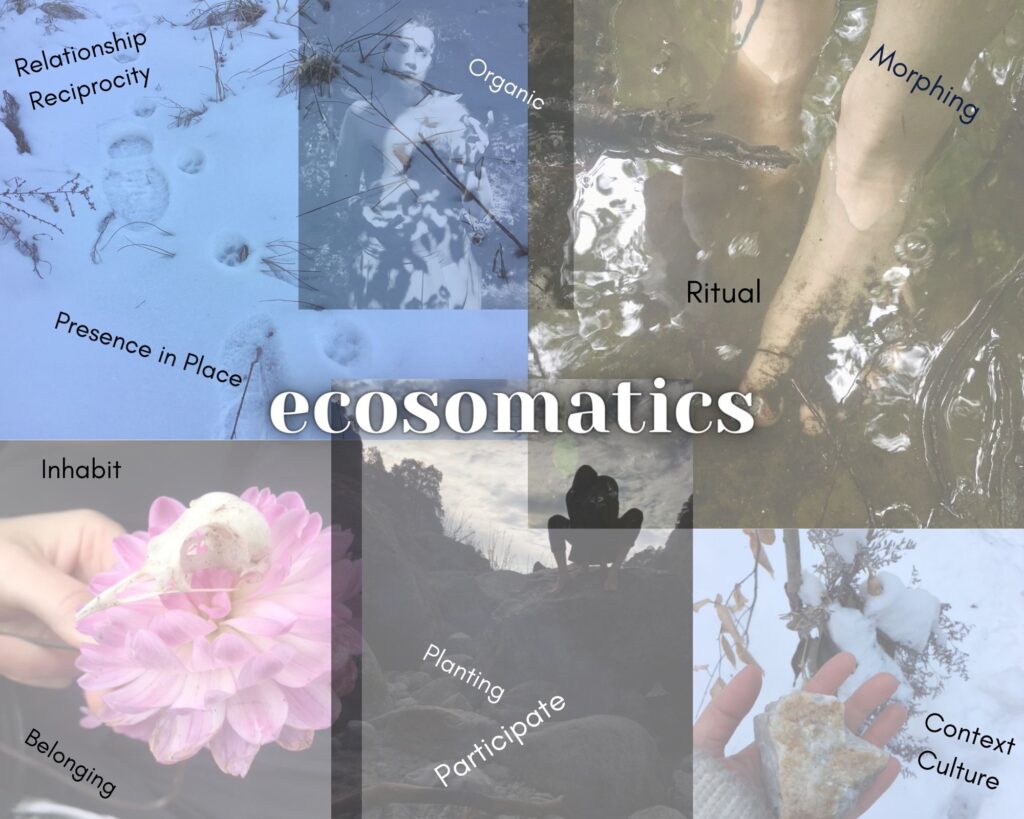
A meandering and non-definite definition of Ecosomatics

Ecosomatics is…
A word that points to inseparability. Just like we may use the word “mindbody” to illustrate that the duality is an illusion, we use “ecosomatics” to illustrate that ecology, environment, and the lived experience of the body are inseparable (see this ISMETA article for some definitions of somatics, this article offering a healthy critique of somatic discourse and history, and my previous article on Nature & the Nervous System for more on bodies in/as environments)

Becoming more conscious of biology, anatomy, and our organic dependencies (how our makeup and needs intersect with all of life on tiny and macro scales)

Moving from a sphere of personal practice into social/communal practice, including the more-than-human

Restoring sovereignty to the land and indigenous people

Perceiving yourself as a bodyworker for the earth and the earth as a bodyworker for you

Being moved by energy from the environment; allowing land to lead

Understanding the cultural contexts of places where you live and understanding that places hold deep meaning, living history, and knowledge. Asking, “What happened here?” and “Which indigenous people belong to this land, how can I understand their total embodiment of this land, and what are their names for these places?” and “What is it like for me to inhabit this place now; what is my sense of belonging or not belonging? What role do I play?”

Also asking: “What are my ancestral homelands? Where do I come from? How does my body remember that land connection through the generations? How might this influence what my body longs for, and when I notice myself feeling most at home?”

Also asking: “How has my body-knowing and bodyfreedom been co-opted and/or manipulated by corporate, colonial, capitalist systems?”and “How do I participate in that or resist that?” and “What can I do right now to drop into my body as it’s relating to the immediate environment? What are the ways my body participates in my immediate environment—what routines, gestures, feelings do I inhabit? What agency do I have over that? What do I receive from where I am, what do I give back to where I am? From whom and to whom?”

Waiting and listening to the elements around you, recognizing these elements within you (i.e. Earth/Air/Fire/Water, or another system of noting natural elements); covering yourself in water, or stone, or…

Listening for all the sounds around you; hearing the overlaps of ecological diversity (or lack thereof); feeling sound in your body

Noting the texture, smell, etc. of plants nearby; making respectful contact with animals and noticing how that relationship feels

Resonating with compost and the life-death-life cycle

Participating in embodied rituals that honor place and connect you to cycles of seasons and nature (being conscious not to harmfully appropriate, giving credit to lineages that have taught you…ideally, connecting with rituals from your own ancestral culture)

Becoming. Butoh. Allowing your humanness to be permeated by other life forms, being moved by animal, plant, mineral, spirit

Feeling kinship with human and more-than-human, exploring what kinship feels like in your body. How do you know when you are in a kinship relationship, or another kind of framework (such as extractive)?

Planting a seed

Noticing how you feel-think-sense-intuit-perceive differently in different places (in particular types of buildings, outside, inside, around certain smells, dampness, landscape, shape, colors, temperatures, spaciousness)

Being and moving consciously through webs of relationship; understanding what impact your actions have on your ecosystem

Finding resilience in diversity

Feeling grounded, literally

Learning the history of plants around you, noticing subtle and big ways the learning changes you and the way you move in the world

Dancing, or singing, as a gift to earth; letting the earth teach you a dance or song

Noticing the suchness and presence of the river, the soil; merging with that surety of existence

Being a rose and embracing your thorn

Respecting places that you are not welcome to enter

Lying down in moss, if the moss consents

What is good for the earth is also usually good for us humans; what harms land and water also harms us – our bodies are connected

Chopping wood, harvesting plants and cooking, digging out a pond, processing wool or other fibers into clothing. To move, and sometimes, to be still.
Sometimes we “use” our bodies but we are not “in” our bodies or feeling much. Can this still be a somatic practice somehow?

Recognizing that this is not a new field; our naming it as a field of study illustrates the ways we have moved away from it (as a result of capitalism, colonization, patriarchy, whiteness), and the ways we recognize the need and yearning to re-inhabit relationship, accountability, and reciprocity

Some references/the books & trainings that most immediately influenced this writing at the time of writing:
EastWest Somatics “Moving Consciously” workshop, taught by Sondra Fraleigh, Michele Ikle, Kelly Ferris Lester, and Amy Bush
“Rituals of Alignment & Balance” class taught by Ananya Chatterjea, especially, but also nearly all of the other lectures that were part of the 2021 Embodied Social Justice Summit
The Voice of the Earth: An Exploration of Ecopsychology by Theodore Roszak
Wisdom Sits in Places: Landscape and Language among the Western Apache by Keith H. Basso